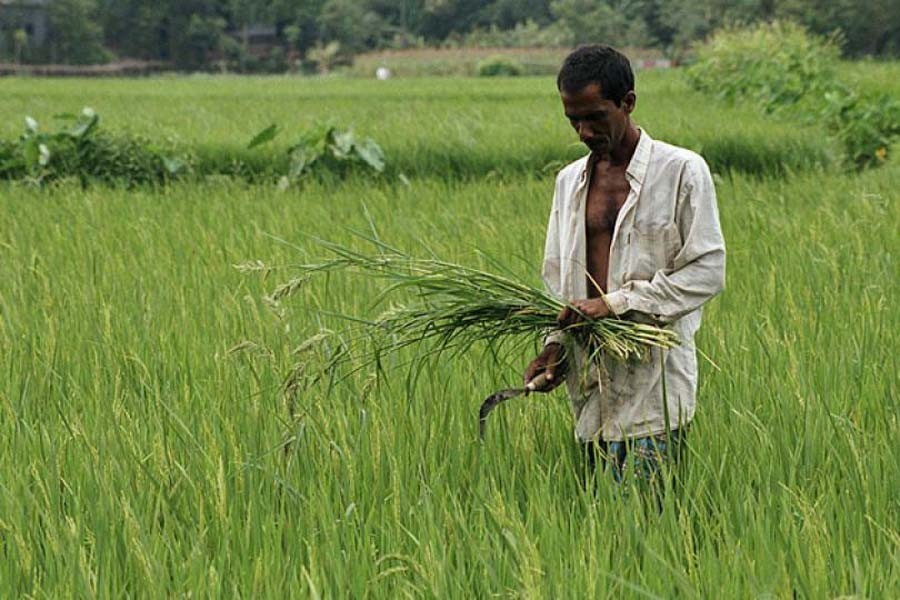There is a need for working out an effective plan to check the country's fast-shrinking arable land and thus maintain the momentum in its food grain production.
Such view was expressed by some agricultural experts at a seminar in the city recently. They say loss of agricultural land would not help boost production, and we must find out a proper solution to deal with the problem.
The fact remains that the government alone can not put an end to unplanned construction of dwelling houses on arable land. In such a situation, experts say, we have to find out a way on how more crops could be produced from a small land. In this regard they opine that non-government organisations (NGOs) operating in the countryside need to supplement government efforts to develop the agricultural sector as the country's 16 per cent GDP comes from agriculture.
It is hard to believe that nearly 69,000 hectares of agricultural land have been shrinking annually due to rapid industrialisation, unplanned urbanisation and increase in rural settlements. Such a situation is pushing the country's food security at risk.
A study carried out in this regard indicated a regular and increasingly declining trend in land available for agriculture. Between 1976 and 2000, around 13,412 hectares of agricultural land was lost. In contrast, in the subsequent period from 2000 to 2010 - 10 years - over 30,000 hectares of land was lost. Rapid urbanisation with new roads and highways is occupying a vast tract of agricultural land every year.
However, through the efforts of Bangladesh Rice Research Institute (BRRI) and the Bangladesh Agriculture Research Council (BARC), the country' crop production per unit of land has considerably increased year by year. This has helped to negate the effect of the continuing decline in availability of arable land all over country.
As urban areas worldwide continue to grow, the population spreads to the surrounding rural and suburban areas. This puts pressure on farmers to give up their croplands and fields so that houses in the countryside can be 'grown'. The loss of agricultural land to urbanisation means an increase in environmental problems such as air quality, transportation problems, loss of critical habitat and green space, and a degradation of water quality.
Another reason that agricultural land is lost is because of soil degradation, which is the loss of a soil's natural fertility. When this occurs, the productivity of the land decreases, without added use of fertilizers and other chemicals.
Urbanisation affects food production in two ways - by removing agricultural land from cultivation, as cities expand, and by reducing the number of family farms, as more farmers move to cities. The spread of cities alone consumes enormous tracts of farmland in much of the world.
As for Bangladesh, long-term outlook appears to be bleak as unplanned growth of population is complicating the process of meeting the demand for food, basic health requirements and educational facilities - triggering unemployment and social unrest.
The prospect is really discouraging as resources are outrunning habitants. Trees are being chopped down for fuel. Climatic disruption in recent times, followed by salinity intrusion, shrinking farmlands and crop losses, has added much to the woes of the people of the country.
What is alarming is that the country, with the world's highest density of population, is fast losing arable land due to growing industrialisation and rapid encroachment of human habitat on farming areas. The country's fast growing population is now looking for new land to build homes while entrepreneurs are going to the remote areas of the countryside to set up factories.
There will be no cultivable land left in Bangladesh in 50 years if lands are taken away for non-farm purposes at the current annual rate. If the trend is not reversed now, the country would permanently lose its food security, making its poor population more vulnerable to volatile international commodity prices.
In order to reverse this trend, the government has taken some steps including banning use of arable land for purposes other than agriculture. This is no doubt a laudable step. A high-level committee suggested that factories and educational institutions that have already been built should now go vertical, instead of grabbing more arable land.
The dwindling size of farms, rise in landlessness and constant depletion of farmland are posing formidable threats to Bangladesh's agriculture, increasing poverty and trapping many ultra-poor people in a vicious circle. The average farm size has been reduced to less than 0.6 hectares and the percentage of landless people stands at 58 in a country where nearly 80 per cent of the ultra-poor live in rural areas.
Worries about farmland depletion at an alarming rate have fallen into deaf ears, while calls for ensuring optimum utilisation of arable land and bringing fallow land under cultivation remain in rhetoric alone. Successive governments concentrated all their focus on higher production of rice, while import bills for fuel, cooking oils and pulses continued to inflate.
Agricultural land loss is a growing problem for Bangladesh with the increase in population. The ironic thing about agricultural land loss is that the land is going away because of a growing population that will require more agricultural products to sustain it. A long-pending suggestion to bring changes in crop pattern for diversifying agriculture remains unattended by the policymakers.
The causes of agricultural land loss are often rooted in the growth strategies of urban areas and are facilitated by politics and economics. The mitigation strategy for the problem can be found in the same places.
Such decline in arable land is worrisome. The authorities concerned should go for regular surveys of arable land to present an accurate figure so that necessary steps can be taken to save this land. It is quite a gigantic task, but it should be done at regular intervals with minute attention.


